
The percent of people who have Euskara as their first language. The numbers for Zuberoa and Nafarroa Beherea are shared. Source: https://www.mintzaira.fr/fileadmin/documents/Aktualitateak/015_VI_ENQUETE_PB__Fr.pdf
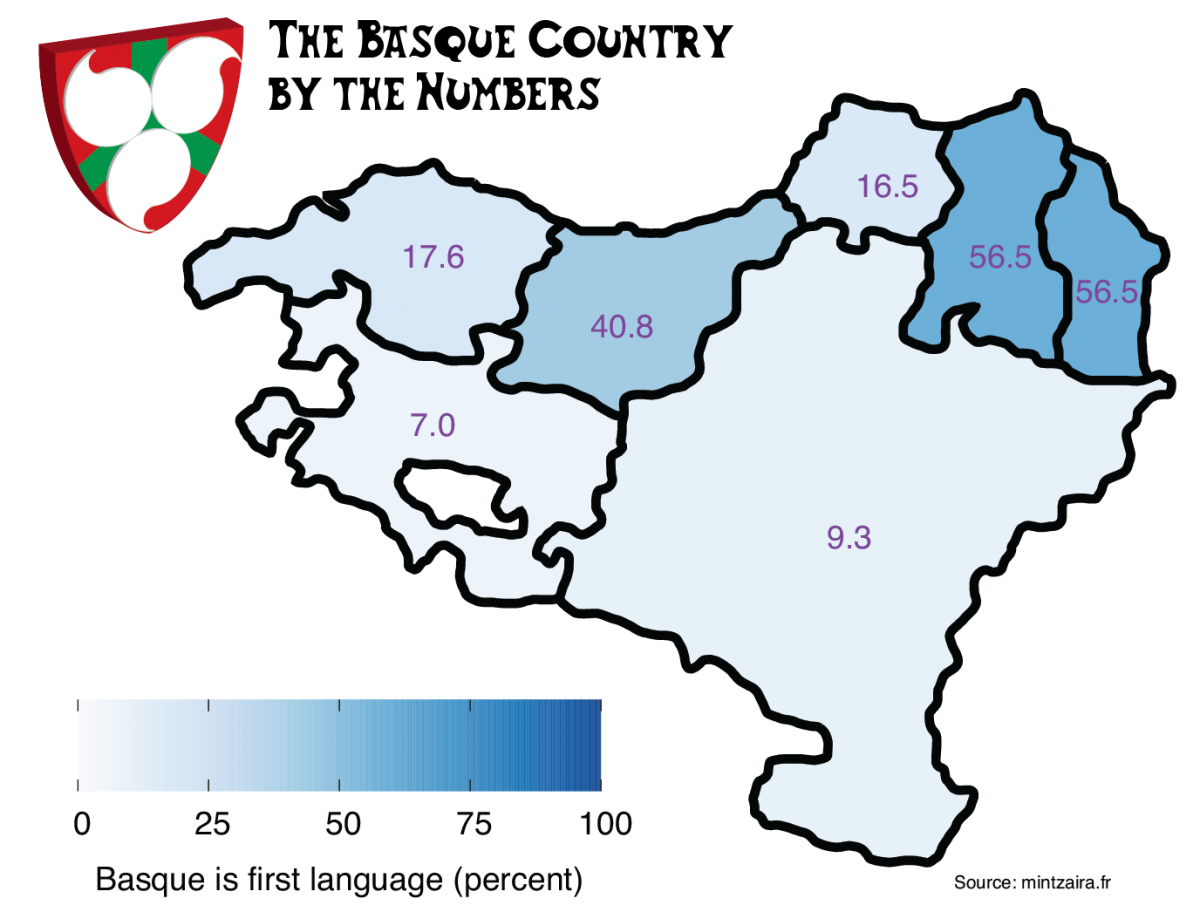

The percent of people who have Euskara as their first language. The numbers for Zuberoa and Nafarroa Beherea are shared. Source: https://www.mintzaira.fr/fileadmin/documents/Aktualitateak/015_VI_ENQUETE_PB__Fr.pdf

It was about nine thirty in the morning when Maite’s little Fiat pulled up again outside of Goikoetxebarri, the baserri where Kepa lived with his mom.
“Mil esker for the ride,” said Kepa over a repressed yawn as he opened the door. “Are you sure you don’t want to crash here for a while, before driving home? If you are as tired as I am…”
“And sleep in that creepy room with those pictures of your uncle?” Maite replied, shaking her head. “No thanks.”
Buber’s Basque Story is a weekly serial. While it is a work of fiction, it has elements from both my own experiences and stories I’ve heard from various people. The characters, while in some cases inspired by real people, aren’t directly modeled on anyone in particular. I expect there will be inconsistencies and factual errors. I don’t know where it is going, and I’ll probably forget where it’s been. Why am I doing this? To give me an excuse and a deadline for some creative writing and because I thought people might enjoy it. Gozatu!
Kepa did have to admit that the middle room was a little creepy. His ama insisted that they keep the photos of his aita’s uncle, Domingo, up on the wall. Domingo had died fighting for the Republicans during the Spanish Civil War as Franco’s forces had sieged Bilbao, and the family had always honored his sacrifice by having many photos of the then-young man around the house. They had all gotten consolidated in the middle bedroom upstairs and now the shrine to his great uncle gave the room a very disturbing atmosphere.
“Fair enough,” Kepa said. “But, at least come in for a coffee. I’m sure ama saw us drive up and already has a glass ready for you.”
Maite smiled in defeat. “Ados,” she said as she turned off the engine and got out of the car.
The smell of coffee filled their senses as they passed the foyer into the small kitchen.
“Egun on!” said Kepa’s ama as the two entered the kitchen. She placed two glasses of coffee on the small table, beckoning them to sit. The table was already filled with cookies and biscuits.
“How are the fish, Mari Carmen?” asked Maite as she took a seat at the table.
Ever since they were children, Maite had always asked Kepa’s ama, Mari Carmen, about her fish. She and her parents had come to dinner at the baserri one night and Mari Carmen had served the best fish Maite had ever tasted. She had assumed that Mari Carmen must have a personal pond full of the best and freshest fish in the Basque Country and ever since she had asked Mari Carmen about her wonderful fish. Even when she grew older, she kept the conceit going as an inside joke.
Mari Carmen smiled. “The fish are wonderful, as always. How was the fiesta?”
“It was great,” said Kepa as he shoved a few of the cookies into his mouth and took a sip of his coffee. “Koldo’s new band is really good. They have some excellent songs and all of them are great musicians. I think they could do really well.”
Maite nodded enthusiastically. “I agree. They’re better than all of the other new bands I’ve heard and better than most of the ones that are on the radio. They are really talented.”
“Pozik nago,” replied Mari Carmen. “I’m glad Koldo has finally found his place.”
Kepa knew what she meant. Koldo had struggled to really find his footing as an adult. He had tried various jobs, working at one of the factories, taking classes to be a mechanic, tending bar, but nothing had stuck. He seemed to only be happy when making music.
Maite finished her coffee and stood up. “Well, I better go. Thanks for the coffee Mari Carmen.”
“Ez horregatik, neska. Ondo ibili,” replied Mari Carmen.
Kepa walked Maite out to her car. “Thanks again for the ride. I really appreciate it. And sorry for being so grumpy at the beginning.”
Maite laughed. “If you weren’t grumpy, you wouldn’t be Kepa.”
Kepa leaned in to give Maite a kiss on each cheek, but Maite grabbed his head and planted a kiss on his lips. “Ikusi arte,” she said with a devious smile.
Kepa just stood there, befuddled, as Maite drove off.
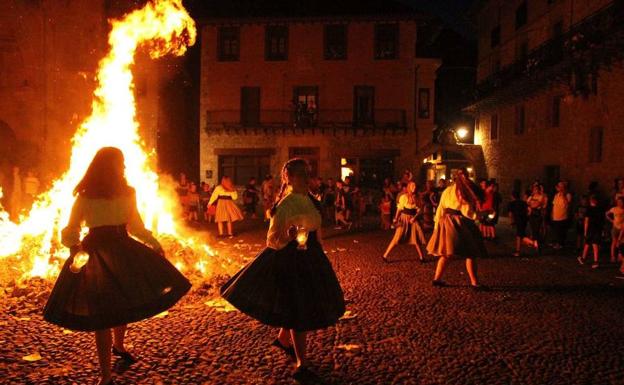
The summer solstice, being the longest day of the year, is an important event in many cultures, marking the changing of seasons. Because of its importance, elaborate rituals and rites have arisen around this date all around around the globe, and the Basque Country is no exception. Many of the pre-Christian elements have been confused and combined with Christian holidays, as the Church placed San Juan’s Feast near the Summer solstice. That said, the echo of many elements of pre-Christian celebrations can still be heard.

Primary source: Aranburu Urtasun, Mikel. Solsticio. Enciclopedia Auñamendi, 2020. Available at: http://aunamendi.eusko-ikaskuntza.eus/es/solsticio/ar-109287/
I think I’ve gotten things working normally again. Hopefully there will be no more glitches for the foreseeable future. If you see anything odd, please tell me.
Best, Blas
Dear visitor. You may have noticed some issues with Buber’s Basque Page, particularly regarding how it is been up and down today and how some images are broken. I think there is something corrupted in my WordPress install. I will probably have to reinstall it at some point, which might mean I go dark for a little while. I’ll try to do this soon and as seamlessly as possible.
If there are any WordPress experts out there who might be willing to give me some advice, I would welcome it.

Kepa passed a red plastic cup to Koldo. “Kalimotxo, ezta?”
Koldo nodded as he took the cup. “Mil esker!”
“That last song was… different,” said Kepa, taking a sip from his own cup. “Don’t get me wrong, I really liked it, but sorginak? Madarikazioak? Curses? Where did you come up with that stuff?”
Koldo shrugged. “That one was all Ainhoa. She wrote that song, music, lyrics, everything.”
Kepa looked at her. “Well?” he asked. “What’s the story?”
Buber’s Basque Story is a weekly serial. While it is a work of fiction, it has elements from both my own experiences and stories I’ve heard from various people. The characters, while in some cases inspired by real people, aren’t directly modeled on anyone in particular. I expect there will be inconsistencies and factual errors. I don’t know where it is going, and I’ll probably forget where it’s been. Why am I doing this? To give me an excuse and a deadline for some creative writing and because I thought people might enjoy it. Gozatu!
Ainhoa smiled as she took a drink. “My mom was born in Nafarroa, in Zugarramurdi, though her family moved to Bizkaia when she was young. She told me a story about some ancestor of hers, or rather, the sister of one of her ancestors. It seems that this sister was one of the healers of the village, and some said she had supernatural powers. When the Inquisition came to town, some of her neighbors, probably jealous or something, accused her of sorginkeria, of witchcraft. The Inquisition tried her and when she refused to recant, they burned her at the stake in the auto de fe in Logroño.” Ainhoa shrugged. “I thought it would make a cool story for a song.”
“That is so cool!” exclaimed Itxaso. “Did she really curse everyone?”
“Who knows?” answered Ainhoa. “We don’t know anything more about her. She was killed over four hundred years ago. Hard to know what really happened back then. I just made up the curse for the song.”
“I bet she really did curse them,” said Itxaso in an excited whisper. “That’s what I would have done, anyways.”
“You don’t really believe in this stuff, do you?” asked Maite incredulously.
Itxaso shrugged. “Who knows, science girl? ‘Izena duen guztiak izatea ere badauke — Everything with a name exists.’ Not everything can be explained in your books.”
“‘Izenak ez du egiten izana — A name does not make something true’,” responded Maite. “I need more proof than just a story to believe it.”
Koldo held up his cup as if to toast. “It doesn’t matter to me if it’s real or not, as long as it’s a kick-ass song!”
The friends all laughed as they took another sip.
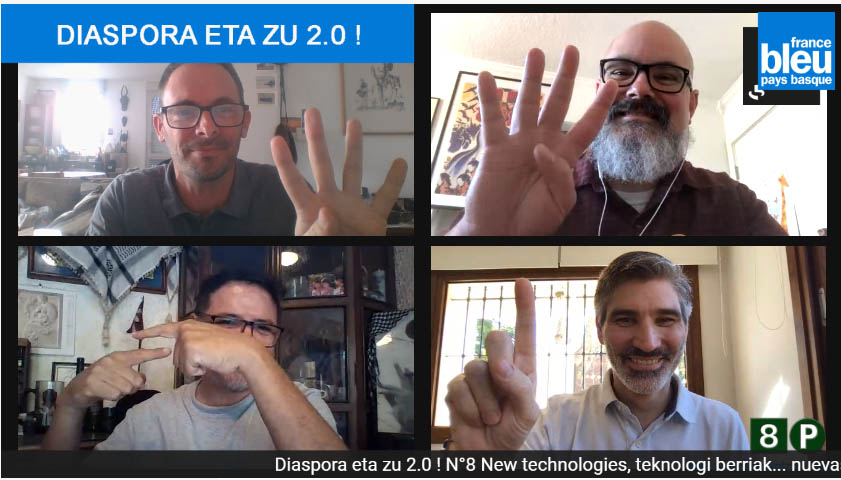
On Sunday, I was fortunate enough to appear on Benoit Etcheverry Macazaga‘s new radio program. Benoit has been a fixture in promoting Basque culture on the Internet for many years, hosting multiple radio programs dedicated to the Basques. His most recent venture, Diaspora eta Zu 2.0, is really focused on the Basque diaspora and connecting the diaspora with the motherland. I’ve “known” Benoit for many years, since the time he contributed an article in French on “le Rebot” (looking at that page, I realize I need to fix a lot of the accented script on my pages!!!). However, it was only this week, when he invited me to participate in Diaspora eta Zu 2.0, that I finally got to “meet” him face to face.

There were four guests on Sunday’s program, which focused on how new technologies impact the diaspora and the relationship with Basques in Euskal Herria. Frequent guest Esther Ciganda, who was born in the United States to two Basque immigrants but has returned to live in Euskal Herria, shared her experiences using the internet to interact with Basques all over the world. Alex Eguia, out of Mexico, runs EuskoBlog, a blog “from the diaspora for the diaspora.” Gonzalo Auza, who was the director of EuskoSare, a website and initiative that aspired to create a Global Basque Community (Gonzalo was one of the first, if not the first, person to use this phrase), joined from Argentina. And then, of course, there was me.
The premise of the shows was new technologies, and you can hear the entire program here. However, there were a few points I wanted to mention and potentially go into a little more deeply.
One topic was about the relationship of the diaspora to Basque culture. Esther made the excellent point that many Basques in the diaspora are more strongly connected to elements of Basque culture such as folk music and dancing than their contemporaries in the Basque Country itself. Many Basques in Euskal Herria respond to questions about if they can dance or if they enjoy folk music with a “meh.” For them, they don’t necessarily need these elements to feel a connection to their Basque culture, as they grow up being Basque. On the other hand, this is a relatively easy way for Basques in the diaspora to display their culture, to express their identity. Without other elements to hold on to, elements that are more challenging to develop such as language, these become very visible and expressive ways to highlight their culture. However, as noted by Alex, often this leads to myths that arise in the Basque diaspora, myths that become part of the diaspora’s culture but don’t necessarily resonate or have much to do with the culture as expressed in Euskal Herria. Myths that, for example, everyone dresses with a txapela, dances the jota, and plays the txistu.
Before, when my dad and people like him came over, and before, there was an influx of people from the Basque Country that brought their experiences with them, that helped informed what their children and the people around them knew about the Basque Country. My dad didn’t dance the jota, didn’t play the txistu, and rarely wore a txapela. But, he was Basque through-and-through and, just by being, he conveyed some aspect of the Basque Country. Now, however, as there is less incentive for people to emigrate from the Basque Country to places like the United States, that flux of people has dropped almost to zero, and that direct connection with the Basque Country has weakened. And, as pointed out by Esther, many in the diaspora never get a chance to visit Euskal Herria, the land of their ancestors, so never have a direct experience. On the other hand, Benoit noted how, even a hundred years ago, to have a cousin in the Americas or Australia was almost part of the definition of being Basque. The people of the Basque Country had a direction connection to the rest of the world through family. That connection is also being lost and, with it, some greater understanding of the rest of the world.
So where does that leave us? The literal ties that bind us together, the men and women that crossed the ocean looking for opportunity and a better life, are slowly disappearing and not being replaced. Both sides are weakened as those ties start to unravel. In the diaspora, as we grab onto dance and folk music as some tangible manifestation of that culture, we become more removed from the reality of the Basque Country. Euskal Herria is a modern, thriving country, pushing the state-of-the-art in science and technology and innovating in areas of gastronomy. It is a place where heavy metal and rap co-exist with folk music, where the serenity of the baserri stands next to the towering skyscapers and hulking Guggenheim. It is a place of contrasts, where certainly the folkloric elements exist and, in many cases, flourish, but where people are creating new industries and living lives that, day to day, focus on concerns other than these visible displays of Basque culture.
And, the people of the Basque Country lose that connection with the rest of the world. They start to lose those advocates that spoke so strongly for them around the world. They lose that base of talent and ideas that came from far away that only helped strengthen the society back home. And, they lose the sense of a global network, the type of interconnectedness that Gonzalo and EuskoSare tried to foster, in which there are Basques all over the world that, in their own little ways, support the Basques back in Euskal Herria.
These connections have another benefit. As discussed by Gonzalo, not everyone finds dance and music to be their preferred way to express their culture, their Basque identity, but in the diaspora, other modes of expressing that identity are lacking or difficult to develop. Dance and music are very visible ways of expressing culture that are relatively easily accessible. For those who aren’t into these things, there may almost be a sense that they aren’t as Basque as others. But, in the Basque Country itself, there are so many other ways one can be Basque. Having strong connections between Euskal Herria and the diaspora provide new opportunities — new modes — of cultural expression and provide for a richer landscape overall for all of us.
The theme of Sunday’s show was new technology and its role in the relationship between the diaspora and the Basques back in the Basque Country. I like to tell a story about my dad that highlights how I think technology might help. Of course, as noted by Alex, technology has its pitfalls, and there are dangers, such as the trolls that constantly arise out of the depths to plague any online community. However, in the long run, I believe technology will help us maintain, at least to some limited extent, the connections between Basques across the world.
When I was a kid, I didn’t know my dad’s family back in the Basque Country at all. He was the eldest of eight children and was the only one to leave Euskal Herria. The rest stayed behind, building lives and families in the homeland. My dad, first as a sheepherder and then as a truck driver, built what he could in the US. But, back then, it was expensive to travel, and the few times he did go back to Euskal Herria — literally less than five times in the first thirty years he lived in the US, typically for a wedding — he went alone. He called his family maybe once a year, around Christmas time, as the calls ended up costing so much. As a result, I had no connection at all with his family. I barely knew their names, I certainly didn’t know the names of their children. I didn’t meet my grandmother until I took my first trip over when I was twenty.
However, near the end of his life, my dad was on his cell phone constantly, talking with his brothers back in Euskal Herria. They talked seemingly daily, calls crossing the globe from both directions. He got to know his youngest brother, who had not been much more than a toddler when my dad left home. He got to know his nieces and nephews better. And, as a result, we all got to know them a bit more, we all got and shared news much more frequently and became just a bit more of a family than we had been before. I witnessed a real benefit to the new technologies that are so pervasive and, yes, in many cases disruptive to our lives. But, I also saw how they could help build new bridges between the Basque Country and the diaspora that might help us keep those connections alive. The materials might be different, but the bridges may yet survive and, hopefully, thrive.
Today, it is well accepted that the Basques were early visitors to the coast of what would be known as North America. They established sites along the coast of what is now Newfoundland to process the whales they hunted and return the final product to Europe. With the local Native Americans, they created pidgin trading languages that surprised later European visitors. However, much of this history would be unknown to us if it wasn’t for one extremely dedicated, tenacious, and remarkable woman, Selma Huxley Barkham.

Primary source: “Enterprising researcher Selma Barkham rewrote a chapter of 16th-century history” by Joan Sullivan, in The Globe and Mail, published May 22, 2020.
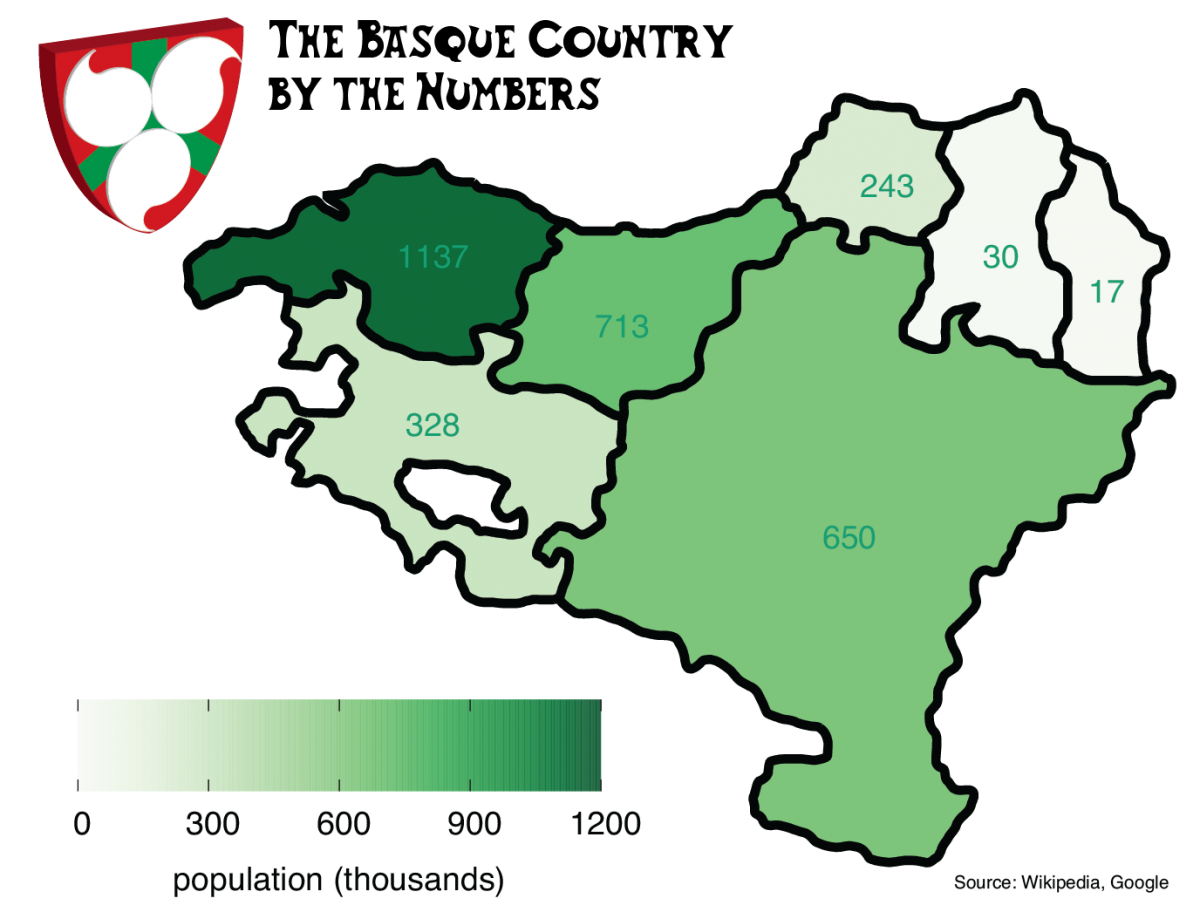

The population of the Basque Country by province.
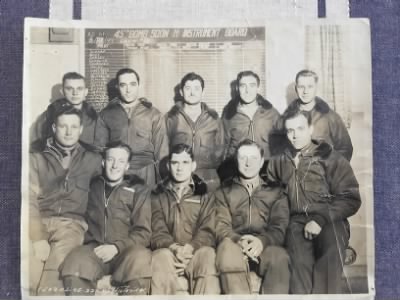
In memory of Dr. Emilia (Sarriugarte) Doyaga (Brooklyn, New York, 1925-2020).
This article originally appeared in Spanish at El Diario.

With the attack on Pearl Harbor in Hawaii, and the invasion of the Philippines, the Japanese Empire began an unstoppable expansionist military campaign across the Pacific against American, British and Dutch possessions in response to logistical support that, since 1941, the United States (USA) had given to the Republic of China in its war with the Japanese (the Second Sino-Japanese War began on July 7, 1937), and to the oil embargo by the Dutch and the British. In December 1941, Japan attacked British colonial territories in Hong Kong, Malaysia, Singapore, and Burma (today Myanmar). This opened a new military front in the global war, in which China, with the support of the United States and the Soviet Union, became a key player in curbing Japanese imperialist ambitions in Southeast Asia and which was baptized the China-Burma-India Theater of Operations. It was the great forgotten military theater of World War II (WWII). An estimated four million Chinese and Japanese soldiers perished as a result of the war, to which should be added between 10 and 25 million Chinese civilians who also died. The Second Sino-Japanese War was the greatest human tragedy in terms of the number of deaths in the entire Pacific War.
“Echoes of two wars, 1936-1945” aims to disseminate the stories of those Basques and Navarrese who participated in two of the warfare events that defined the future of much of the 20th century. With this blog, the intention of the Sancho de Beurko Association is to rescue from anonymity the thousands of people who constitute the backbone of the historical memory of the Basque and Navarre communities, on both sides of the Pyrenees, and their diasporas of emigrants and descendants, with a primary emphasis on the United States, during the period from 1936 to 1945.
THE AUTHORS
Guillermo Tabernilla is a researcher and founder of the Sancho de Beurko Association, a non-profit organization that studies the history of the Basques and Navarrese from both sides of the Pyrenees in the Spanish Civil War and in World War II. He is currently their secretary and community manager. He is also editor of the digital magazine Saibigain. Between 2008 and 2016 he directed the catalog of the “Iron Belt” for the Heritage Directorate of the Basque Government and is, together with Pedro J. Oiarzabal, principal investigator of the Fighting Basques Project, a memory project on the Basques and Navarrese in the Second World War in collaboration with the federation of Basque Organizations of North America.
Pedro J. Oiarzabal is a Doctor in Political Science-Basque Studies, granted by the University of Nevada, Reno (USA). For two decades, his work has focused on research and consulting on public policies (citizenship abroad and return), diasporas and new technologies, and social and historical memory (oral history, migration and exile), with special emphasis on the Basque case. He is the author of more than twenty publications. He has authored the blog “Basque Identity 2.0” by EITB and “Diaspora Bizia” by EuskalKultura.eus. On Twitter @Oiarzabal.
Josu M. Aguirregabiria is a researcher and founder of the Sancho de Beurko Association and is currently its president. A specialist in the Civil War in Álava, he is the author of several publications related to this topic, among which “La batalla de Villarreal de Álava” (2015) y “Seis días de guerra en el frente de Álava. Comienza la ofensiva de Mola” (2018) stand out.
The invasion of Malaysia occurred on December 8 and was fully occupied by February 1942. From there, Japan launched another attack on the island of Singapore, south of the Malay Peninsula. On February 15, British troops from Singapore surrendered. In late December, Japan invaded Burma with 100,000 soldiers and nearly 700 aircraft. The British capitulated in April 1942. The invasion of Burma meant for Japan the capture of military supplies vital for the Allies and particularly for the United States, such as natural rubber. 90% of all natural rubber production grew within a 15-degree radius of Singapore. The response from the US government did not take long, which formed a consortium of rubber manufacturing companies with the objective of replacing natural rubber with synthetic ones. The multinational companies of today Firestone and later Goodyear would manufacture, in the spring of 1942, the first synthetic rubber in history.

Furthermore, Burma was a strategic target for Japan in its final victory against the Chinese resistance. Japan needed to cut off supplies to China, which were mainly carried out through the so-called Burma Road, built in 1938 with a length of 1,154 kilometers, that connected Yangon, to the south of Burma, and Kunming, in the Chinese province of Yunnan. Burma was the main country through which China supplied itself in its objective of defeating Japan since the invasion of 1937. The taking of Yangon in March 1942 meant control of the Burma Road and the end of allied supplies by land to China. (Japan had China isolated by sea since 1937.) The only allied solution at the time was to supply Chinese nationalists and US Air Force units by air from, initially, Dinjan in the province of Assam, India, to the city of Kunming — through the eastern tip of the Himalaya mountain range, baptized by the pilots as “hump” (with elevations above 4000 meters). The 800-kilometer-area route, also known as the Aluminum Trail, was inaugurated on April 8, 1942.

Among the children of immigrant Basques who flew over the Aluminum Trail, there were coincidentally four young people from Humboldt County, in the State of Nevada: Santiago Arriola Onandia and Joseph Malaxechevarria Plaza — both born in 1919 in the small rural town of Paradise Valley — John Montero Bidegaray, born in 1922 at the Leonard Creek family ranch, and Domingo Arangüena Bengoa, born in 1917 in Winnemucca. Santiago Arriola was recruited on October 17, 1941 before the United States entered the war. He joined the Air Force and received radio operator training at Scott Air Force Base in Illinois. Promoted to Staff Sergeant, he departed for India under sealed orders from Sioux Falls (South Dakota) on an extraordinary journey that took him first to Greensboro (North Carolina), then to Miami Beach (Florida), where he caught a flight that would fly a route via Puerto Rico, Belim, Ascension Island, the Gold Coast of Africa (present Ghana), Khartoum, and Aden. His plane had engine problems and was forced to land in Madagascar, then continude on to Karachi, Barrackpore and, finally, the Kurmitola (Bengal) airfield, where he was assigned to the China-India Division of Transport Command. He flew the C-109 “Liberator Express” aircraft, modified as fuel transports, in what became known as the “Gas runs” from India to China. In late 1944 his unit was posted to the Shamshernagar Indian Airfield, where it remained until it was bombed by the Japanese in June 1945. By the end of his term of service he had crossed the Himalayas more than 100 times. At the end of the war, he was flown to Karachi, where he took a boat that would take him to New York. Demobilized in Fort Douglas, Utah, he arrived at his Paradise Valley home just in time for Christmas. He died in 1994.
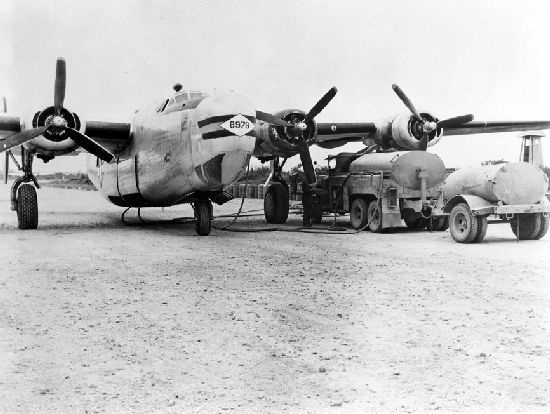
Joseph Malaxechevarria (in the USA he was known as Joseph Echevarría) enlisted the same day of the attack on Pearl Harbor. He entered the Air Force and got a place at the technical training school at the Chanute Air Force Base (Illinois), where he graduated as a mechanic. He was sent to North Africa in late 1942 and then to Sicily, reaching the rank of Staff Sergeant. Later he was sent to India and China, where he had the opportunity to fly over the eastern end of the Himalayas. He received the Bronze Star for having successfully completed 150 hours of operational flight on transport aircraft in the months of January and February 1945 on the dangerous and difficult air routes between India and China, “while flying both day and night at high altitudes above impassable mountains which required courage and skill for long operating periods.” In the spring of 1945, he returned to the United States and was assigned to the fighter jet base in Indian Springs, Nevada, where he graduated. He passed away in 2010 at the age of 91.
An estimated 650,000 tons (81% of all supplies and people entering China) were transported by air between India and China throughout the war. By volume transported, it was the largest and most extended strategic airlift in the history of aviation until 1949. The human and aircraft cost was considerable, due to adverse weather conditions, extraordinary altitude, mechanical failures, the inexperience of pilots, and the occasional attacks by Japanese fighters. The pilots did not have a radar or a control tower and the radios were inadequate. Almost 1,700 crew and passengers and about 600 planes that made the India-China route were left for dead or missing. Among the latter is John Montero.
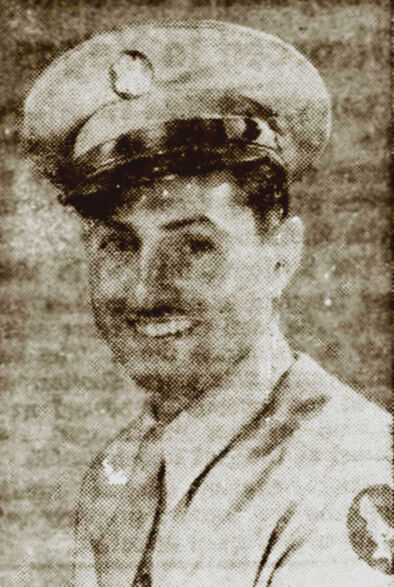

Montero was drafted on October 28, 1942 and entered the Air Force. He graduated as a gunner, joining the 45th Squadron of the 40th Bombardment Group, being part of the crew of the B-29 Superfortress “Stockett’s Rocket,” which was piloted by Captain Marvin M. Stockett. The B-29s began arriving at the base in Kuangchan (China) on April 24, 1944, but the first combat departure would not take place until June 5, 1944, from airfields in India. The objective was to bomb railway workshops in Bangkok (Thailand), losing up to five planes due to technical problems. The next mission was on June 15, 1944, targeting Japan, in what would be the first such attacks since the 1942 “Doolittle” Raid. Three B-29s were lost, including the plane that Sergeant Montero was flying in, who covered the gunner position on the left side. After taking off without incident from its base in Chakulia (India), “Stockett’s Rocket” disappeared without having been able to learn what its destination was, and its loss was officially reported. Everything indicates that they crashed when they could not pass the Himalayas. The news of Montero’s disappearance reached his hometown of Leonard Creek just a month later, and a mass was celebrated in his memory in the Catholic Church of Saint Paul in Winnemucca on July 9, 1944. The family was informed that he died during a routine flight from Chakulia (India) to Hsing-Ching (China) and that the last radio contact occurred when they were flying over Jorhat (India). Neither the plane nor, obviously, the bodies were ever found. Montero is memorialized in the Manila American Cemetery.
Domingo Arangüena was drafted on March 10, 1942. Destined for the Air Force, he trained as a mechanic and flight engineer for the B-25 medium bomber “Mitchell” at Mather Air Force Base in Sacramento, California. He then began a long journey that took him to North Africa, Egypt, Iran, Indochina, Burma and India, establishing his base of operations in Jorhat. Just after the war, he took part in search flights over the Himalayas, India, and Burma, where hundreds of planes had been lost, including John Montero’s B-29 “Stockett’s Rocket”. After returning to Winnemucca, he had the opportunity to speak with Montero’s father, Ramón, who asked him if he knew that country well and if it would be possible to go look for his son. He replied that there were planes searching and that he participated in many of those missions after the end of the war. About 1,200 crew members were happily rescued or returned to base on their own during the war. Arangüena passed away in 2004 at the age of 86.
Without the sacrifice and iron will of the air command and its personnel, it would not have been possible to distribute the resources necessary for the defense of China, which would have led to its military defeat. The success of the heroic operations over the Himalayas led Japan to keep more than a million soldiers and numerous resources on the Chinese front, without being able to dispose of them on the Pacific front, which greatly facilitated the final success of the Allies (1).
(1) Launis, Roger D., Scott, Beth F., Rainey, James C., y Hunt, Andrew W. (eds. 2000). The Hump Airlift Operation. The Logistics of War: A Historical perspective. Air Force Logistics Management Agency (U.S. Air Force). pp. 110–113